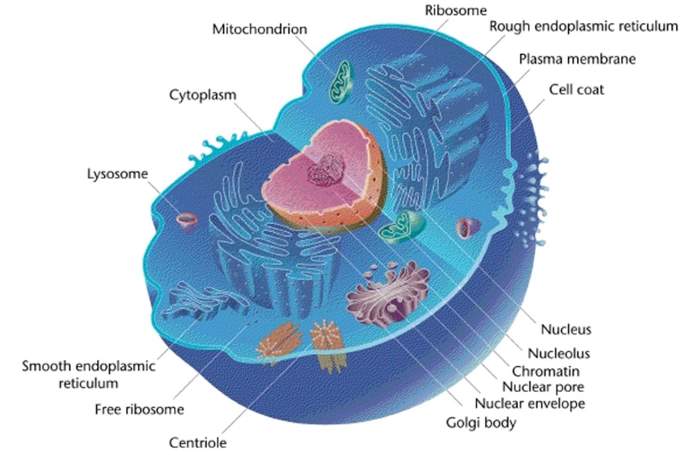Cell & Organelles
5 years ago 3481

|
1. Cell Membrane/Plasma Membrane
2. Protoplasm
• Cytoplasm
• Nucleus
|
|
Nucleus
1. Nuclear Membrane
2. Nucleolus
3. Nucleoplasm
4. Chromatin
|
|
Cytoplasm
1. Organelles (Living)
2. Inclusion (Non-living, Temporary)
|
| Outer parts of both phospholipid layer is a hydrophilic part (i.e soluble in water). |
| Inner part of both phospholipid layers form the middle part - hydrophobic part (i.e not soluble in water). |
| Protein present through the vertical length of membrane → called as integral protein (transmembrane protein) |
| Protein present in the inner aspect of the membrane near the transmembrane protein called → peripheral protein. |
|
Similarly, it consists of carbohydrate molecules as glycoprotein and glycolipid commonly called as glycocalyx.
|
| • It forms the boundary of the cell. |
| • Maintains the shape of the cell. |
| • Acts as a selective barrier that regulates the passage of certain materials into or out of the cell. |
| • Serves as the site of the receptor (protein act as receptor). |
| • Limits the protoplasmic content of the cell. |
| Organelles: | Inclusions: |
| • Permanent components of cell | • Temporary components |
| • Highly organized physical Structure | • They are raw food materials or product of metabolism |
| • Eg. Mitochondria, ER, Golgi bodies | • Eg: Secretory granules, pigment, CHO, Protein |
| DNA | RNA |
| • Double-stranded | • Single-stranded |
| • Found in nucleus (99%), mitochondria (1%) | • Found in the cytoplasm (90%), nucleus (10%.) |
| • nitrogen bases are Adenine, Guanine, cytosine, Thymine | • Nitrogen bases are Adenine, Guanine, cytosine, Uracil |
| • Contain deoxyribose sugar | • Contain ribose sugar |
| • Sum of purine bases is equal to the sum of pyrimidine bases. | • Sum of the purine base is not equal to the sum of pyrimidine bases. |
| • Function Carry genetic information. |
• Function: Translate genetic information of DNA into protein |
| • Histone protein present. | • Histone protein absent. |
| • Polymer of deoxy-ribonucleotides | • Polymer of ribonucleotides |
Comments (0)